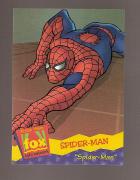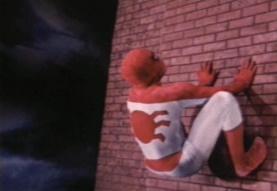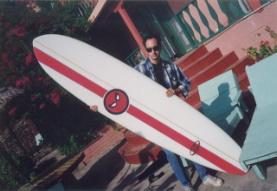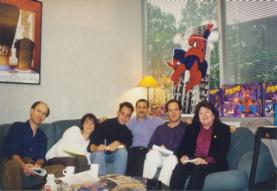 |
|
· Episode Guide · Episode Reviews · Character Bios · Interviews · Archives · DVD Releases · Comic Gallery · Title Sequence · Downloads · Live-Action Movies · Message Board · MAA Home Page
 |
|
|
Jim Kreig served as a staff writer for Spider-Man: The Animated Series, originally breaking into the business to work on the show. Kreig recounts to Marvel Animation Age his experience on the show and the character in general. Take it away, Jim!
MAA: How did you come to work on Spider-Man: The Animated Series?
Krieg: As I so infrequently give interviews, allow me to give you the extra-long version (wise readers
may choose to skip ahead to the Berkowitz section see here ). I don’t know if you can see it, but it is actually labeled
“Spider-Man” across the front, just in case the underarm webbing didn’t tip you off. I really wanted the official
Ben Cooper plastic Spider-Man costume (see right), but I come from hearty, frugal “let’s make it ourselves!” stock.
 I particularly responded to the underfunded Ralph Bakshi seasons, where the stories were padded to a half
hour with infinitely repeated images of Spidey swinging across a green and purple skied Manhattan while
acid-tinged, guitar-heavy jazz played for what seemed like hours on end. To me the show was less about
Spider-Man’s adventures and more about his commute. And I couldn’t get enough of it.
I particularly responded to the underfunded Ralph Bakshi seasons, where the stories were padded to a half
hour with infinitely repeated images of Spidey swinging across a green and purple skied Manhattan while
acid-tinged, guitar-heavy jazz played for what seemed like hours on end. To me the show was less about
Spider-Man’s adventures and more about his commute. And I couldn’t get enough of it.
Many years later, while I was a film student at NYU, I attempted to excise those still repeating
web-swinging montages from my mind’s eye by re-creating them for my senior project, a 16mm film I called
VIVA SPIDERMAN!(see below left).
This project ended up on the desk of Sid Iwanter at Fox Kids while I was in my second year of graduate
studies at the American Film Institute in Los Angeles (and, yes, I did spend most of my twenties in film
school). He intuitively knew a obsessed fan when he saw one and promptly introduced me to John Semper,
producer, story editor and mentor.
I submitted some ideas to John, who in turn showed them to the great Stan Lee.
Somewhere in my files, I have the note Stan wrote on my pitches: “Jim Crieg [sic] writes well, but
he doesn’t ‘get’ Spidey.” In my youthful hubris, I believed Stan was wrong on both points.
 Inexplicably, John hired me to write an episode anyway. We broke HYDRO-MAN together and, after wresting with my muse for a while, I handed in a too-long, art-school precious and completely unusable script. It took some begging, but John graciously gave me twenty-four hours to put the script into shape, for which I will always be grateful. Because that was the moment my life as a professional writer started.
Inexplicably, John hired me to write an episode anyway. We broke HYDRO-MAN together and, after wresting with my muse for a while, I handed in a too-long, art-school precious and completely unusable script. It took some begging, but John graciously gave me twenty-four hours to put the script into shape, for which I will always be grateful. Because that was the moment my life as a professional writer started.
MAA: How was working on Spider-Man different from the various other shows you’ve worked on?
Krieg: Every show I’ve ever had the opportunity to write on has proven to be invaluable in my ongoing education
as a writer. This is particularly true of SPIDER-MAN, as it was my first gig and John took pains to show me the
ropes. Not just of writing, but, more importantly, of rewriting. Because that’s what a TV writer spends most of
his or her time doing. I learned more in eighteen months on SPIDER-MAN than I did in six years of film school.
Sorry. It’s true.
MAA: The show used a serialised style of storytelling, rather than the 22 minute “mini movie” episodes, which were considered the norm at the time. Do you think this was the right direction to take the series? What are the advantages and disadvantages of both as a writer?
Krieg: Clearly, John chose the best way to tell this story. Sure, the supervillain fights are fun, but really it’s the soap-opera of Peter Parker’s life that keep the audience invested in the character. Will Harry ever forgive him for stealing MJ? Will Felicia marry the Hobgoblin? Will Anna Watson ever get off his back? That’s the good stuff.
MAA: You wrote two episodes featuring C list villains from the comics – Hydro Man and The Spot. What process went into trying to make them more interesting villains for the small screen and how well did you think you did?
Krieg: As for Hydro Man, it was a long time ago, but I think we weren’t allowed to use Sandman, because he was going to be the
villain in the Jim Cameron Spider-Man movie that never happened. So, John just substituted Hydro-Man. I kind of
hoped the fact that he went to prom with Mary Jane made him slightly more interesting. (Total aside: Hydro-Man has
Mary Jane meet her at the Hotel Seville, which was where I lived when I went to NYU. Now you know.)
And the Spot? Well, I think we introduced him just to make an excuse for those interdimensional portals
we used over and over again in lieu of killing people. He was such a silly character, that the only thing
I remember about writing that was trying to jam as many puns off the word “spot” into the script. “That hit the spot!”
Stuff like that. Mark Hoffmeier actually wrote that outline, I just wrote the teleplay. It was a real team effort on TAS. John called all the shots, but story outlines usually went through the hands of an uncredited staff writer or two before going to script.
 MAA: Carnage was originally conceived a serial killer. Did you find him a difficult character to
write for being that BS+P wouldn’t allow you to show him kill anyone? How did you work around it?
MAA: Carnage was originally conceived a serial killer. Did you find him a difficult character to
write for being that BS+P wouldn’t allow you to show him kill anyone? How did you work around it?
Krieg: I think Stan Berkowitz and I just wrote it as though Cletus Kassidy was a serial killer and just never mentioned what he was wanted for. The cops certainly acted like he was a serial killer, they just didn’t specifically say, “Boy, that Kassidy is one bad serial killer.” Come to think of it, I don’t think we could use the word “kill”. He would’ve had to be a serial harmer or maybe a serial obliterator.
MAA:
In a bold move, Turning Point killed off Mary Jane, brought her back, only to kill her off again as a water based clone of the original. What was your thought/input into the whole storyline?
Krieg: TURNING POINT was the greatest. John had me reread every classic Lee/Romita Goblin story
(we had every issue in a filing cabinet… seriously) and kind of mush it into one awesome episode.
It was really fun. I got to write the outline for that one and had a hand in the script as well.
And of course, we had to throw her off the bridge, because Gwen Stacy’s death is probably the most
iconic moment in the comic book’s history and, since we couldn’t kill her, hurling poor Mary Jane into a
parallel dimension was a pretty good alternative.
She’s still there, you know. Even to this day, I’ll be driving along minding my own business and think,
“Oh, man, MJ is still plummeting through that red cloudy limbo!”
As for the clone stuff? I don’t really think anyone was desperate to see Mary Jane’s shape-shifting
stalker again, but it was one way to have Peter and MJ get married without really having them get married.
I wonder what Pete’s legal status is? Widowed? Annulment do to the fact that bride was just… water?
MAA: You helped write the penultimate episode “I Really, Really Hate Clones”. What are your thoughts on
the finale? Do you think Spider-Man works as a dimension hopping hero?
Krieg: Oh, heck yeah! That was a blast. Mark and I got to break that episode with John and had to turn the script
around quickly, so I wrote the first act and he wrote the second. At the point I handed off the script to Mark,
Spider-Carnage has destroyed all possible universes everywhere! It’s my favorite act break jeopardy ever!
MAA: Which episodes are you favourites from the show? Is there any you dislike?
 Krieg: I love them all, the way you love your old high school once you
don’t go there anymore. The real joy of this show for me was
collaborating with awesome writers like Stan Berkowitz, Mark Hoffmeier,
Ernie Altbacker, Meg McLaughlin and, of course, John Semper. By the
way, I do make an appearance in ATTACK OF THE OCTOBOT. I’m one of the
plucky taxi drivers! Don’t blink… (see left). And you can see my
then girlfriend (now wife!) in THE GAUNTLET OF THE RED SKULL. She’s one of the vampires menacing the Black
Cat right before she’s whisked off to the Secret Wars (
Krieg: I love them all, the way you love your old high school once you
don’t go there anymore. The real joy of this show for me was
collaborating with awesome writers like Stan Berkowitz, Mark Hoffmeier,
Ernie Altbacker, Meg McLaughlin and, of course, John Semper. By the
way, I do make an appearance in ATTACK OF THE OCTOBOT. I’m one of the
plucky taxi drivers! Don’t blink… (see left). And you can see my
then girlfriend (now wife!) in THE GAUNTLET OF THE RED SKULL. She’s one of the vampires menacing the Black
Cat right before she’s whisked off to the Secret Wars ( Best. Show. Ever.
Best. Show. Ever.
MAA: What are you currently working on?
Krieg: Right now I’m writing a live-action pilot for Nickelodeon and working on a made-for-cable movie
for them as well. Hopefully, a year from now you’ll be interviewing me about both of these projects.
Or at least… you would be, if they were animated.
The Marvel Animation Age would like to thank Mr. Krieg for his participation in this interview,
the various pictures and just plain cool stuff he sent to the webmaster and his work on the show.
Cheers Jim!
